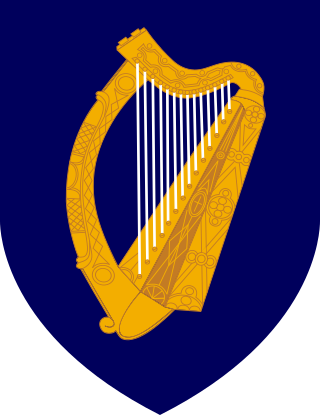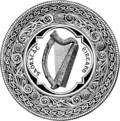
Ireland is a parliamentary, representative democratic republic and a member state of the European Union. While the head of state is the popularly elected President of Ireland, it is a largely ceremonial position, with real political power being vested in the Taoiseach, who is nominated by the Dáil and is the head of the government.

A prime minister or chief of cabinet is the head of the cabinet and the leader of the ministers in the executive branch of government, often in a parliamentary or semi-presidential system. A prime minister is not the head of state, but rather the head of government, serving as the chief of the executive under either a monarch or a president in a republican form of government.

The president of Ireland is the head of state of Ireland and the supreme commander of the Irish Defence Forces.

The Taoiseach is the head of government or prime minister of Ireland. The office is appointed by the President of Ireland upon the nomination of Dáil Éireann and the office-holder must retain the support of a majority in the Dáil to remain in office.

The Irish Free State, also known by its Irish name Saorstát Éireann, was a state established in December 1922 under the Anglo-Irish Treaty of December 1921. The treaty ended the three-year Irish War of Independence between the forces of the Irish Republic – the Irish Republican Army (IRA) – and British Crown forces.

The governor-general of the Irish Free State was the official representative of the sovereign of the Irish Free State from 1922 to 1936. By convention, the office was largely ceremonial. Nonetheless, it was controversial, as many Irish Nationalists regarded the existence of the office as offensive to republican principles and a symbol of continued British involvement in Irish affairs, despite the Governor-General having no connection to the British Government after 1931. For this reason, the office's role was diminished over time by the Irish Government.
The president of Dáil Éireann, later also president of the Irish Republic, was the leader of the revolutionary Irish Republic of 1919–1922. The office was created in the Dáil Constitution adopted by Dáil Éireann, the parliament of the Republic, at its first meeting in January 1919. This provided that the president was elected by the Dáil as head of a cabinet called the Ministry of Dáil Éireann. During this period, Ireland was deemed by Britain to be part of the United Kingdom of Great Britain and Ireland, but the Irish Republic had made a unilateral Declaration of Independence on 21 January 1919. On 6 December 1922, after the ratification of the Anglo-Irish Treaty, the Irish Free State was recognised by Britain as a sovereign state, and the position of the President of Dáil Éireann was replaced by that of President of the Executive Council of the Irish Free State but, as a Dominion of the British Empire, King George V was head of state until the dominion status was rescinded in 1949.

The Tánaiste is the second-ranking member of the government of Ireland and the holder of its second-most senior office. They are the equivalent of a deputy prime minister in other parliamentary systems.
In a parliamentary or semi-presidential system of government, a reserve power, also known as discretionary power, is a power that may be exercised by the head of state without the approval of another branch or part of the government. Unlike in a presidential system of government, the head of state is generally constrained by the cabinet or the legislature in a parliamentary system, and most reserve powers are usable only in certain exceptional circumstances.
The 5th government of Ireland, commonly known as the First Inter-Party Government, was formed after the 1948 general election held to the 13th Dáil on 4 February. It was an Irish government of Fine Gael, the Labour Party, Clann na Poblachta, Clann na Talmhan and the National Labour Party—and one TD who was an independent, James Dillon. The parties had many different aims and viewpoints, but opposition to Fianna Fáil overcame difficulties in forming a government; Éamon de Valera had led a series of single-party Fianna Fáil governments since 1932. The cabinet was made up of representatives of all parties, and ministers were given a great degree of independence. Some key events during the lifetime of the government include the declaration of the Republic of Ireland in 1948 and the crisis surrounding the Mother and Child Scheme in 1951. It lasted for 1,212 days.

The Vice-President of the Executive Council was the deputy prime minister of the 1922–1937 Irish Free State, and the second most senior member of the Executive Council (cabinet). Formally the Vice-President was appointed by the Governor-General on the nomination of the President of the Executive Council, but by convention the Governor-General could not refuse to appoint a vice-president whom the president had selected.

The Constitution of Ireland vests executive authority in the Government of Ireland, which is headed by the Taoiseach, the head of government. The government – also known as the cabinet – is composed of ministers, each of whom must be a member of the Oireachtas, which consists of Dáil Éireann and Seanad Éireann. Most ministers have a portfolio of specific responsibilities such as departments or policy areas, although ministers without portfolio can be appointed.
The Executive Council was the cabinet and de facto executive branch of government of the 1922–1937 Irish Free State. Formally, executive power was vested in the Governor-General on behalf of the King. In practice, however, it was the Council that governed, since the Governor-General was bound to act on its advice. The Executive Council included a prime minister called the President of the Executive Council and a deputy prime minister called the Vice-President. A member of the Council was called an executive minister, as distinct from an extern minister who had charge of a department without being in the Council.
Dissolution of a legislative assembly is the simultaneous termination of service of all of its members, in anticipation that a successive legislative assembly will reconvene later with possibly different members. In a democracy, the new assembly is chosen by a general election. Dissolution is distinct on the one hand from abolition of the assembly, and on the other hand from its adjournment or prorogation, or the ending of a legislative session, any of which begins a period of inactivity after which it is anticipated that the same members will reassemble. For example, the "second session of the fifth parliament" could be followed by the "third session of the fifth parliament" after a prorogation, but would be followed by the "first session of the sixth parliament" after a dissolution.

The state known today as Ireland is the successor state to the Irish Free State, which existed from December 1922 to December 1937. At its foundation, the Irish Free State was, in accordance with its constitution and the terms of the Anglo-Irish Treaty, governed as a constitutional monarchy, in personal union with the monarchy of the United Kingdom and other members of what was then called the British Commonwealth. The monarch as head of state was represented in the Irish Free State by his Governor-General, who performed most of the monarch's duties based on the advice of elected Irish officials.
The Constitution Act 1936 was an amendment to the Constitution of the Irish Free State that removed all reference to the King, to the office of Governor-General, and almost completely eliminated the King's constitutional role in the state. Under the Act most of the functions previously performed by the King and his Governor-General were transferred to various other organs of the Irish government. The only role retained by the King was as representative of the state in foreign affairs. The amendment passed through the Oireachtas at the same time as the External Relations Act, becoming law on 11 December 1936. Its long title was:
An Act to effect certain amendments of the Constitution in relation to the executive authority and power and in relation to the performance of certain executive functions.
In the Irish Free State, an extern minister, formally a Minister who shall not be a Member of the Executive Council, was a minister who had charge of a department but was not a member of the Executive Council. Extern ministers were individually nominated by Dáil Éireann, whereas of the Executive Council only the President was: he in turn nominated the other members. All ministers were formally appointed by the Governor-General. The Executive Council included the senior ministers, exercised cabinet collective responsibility, and had to be TDs ; the extern ministers filled more junior technocratic roles, and need not be legislators, though in fact all were TDs. In practice, all ministers formed a united administration, and no extern ministers were appointed after 1927.

The Ministers and Secretaries Acts 1924 to 2020 is the legislation which governs the appointment of ministers to the Government of Ireland and the allocation of functions between departments of state. It is subject in particular to the provisions of Article 28 of the Constitution of Ireland. The Acts allow for the appointment of between 7 and 15 Ministers of Government across 17 Departments, and for the appointment of up to 20 junior ministers, titled Ministers of State, to assist the Ministers of Government in their powers and duties.
The granting, reserving or withholding of royal assent was one of the key roles, and potentially one of the key powers, possessed by the Governor-General of the Irish Free State. Until it was granted, no bill passed by the Oireachtas could complete its passage of enactment and become law.











